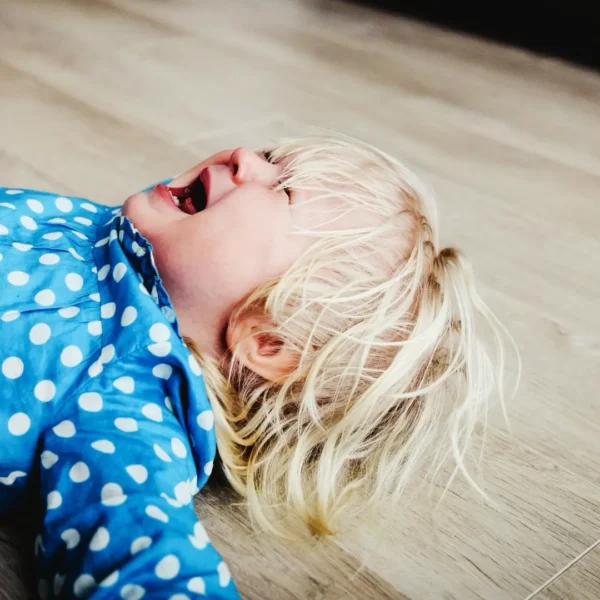
Many parents struggle to understand where the line is between setting boundaries and issuing threats. And the line certainly does seem blurry at times. Let’s clear up the confusion so you can feel more confident, calm, and connected in your parenting.
Do You Ever Wonder… Am I Setting a Boundary or Making a Threat?
I hear this question from parents all the time and it’s an important one to ask.
The truth is, the difference between a threat and a boundary can feel subtle in the moment, especially when you’re overwhelmed, frustrated, or desperate to regain control. But the long-term impact of each is quite different.
Let’s walk through the differences together.
What Is a Threat?
Threats are typically an emotional reaction—a burst of frustration, overwhelm, or even embarrassment. They tend to come out when you feel like you’re out of options, backed into a corner, or unsure how else to get your child to comply.
Threats can sound like:
- “If you don’t stop that right now, then no ice cream later!”
- “How many times have I told you! That’s it! I’m throwing all your toys away!”
- “If I see you two fighting one more time, we’re never coming here again!”
- “Enough! I’m never buying you anything again!”
If any of these sound familiar, don’t worry, you’re in good company. Parenting is hard, and sometimes our kids trigger us in ways that feel impossible to manage calmly.
Here’s what to keep in mind about threats:
- They often come from a place of panic, anger, or helplessness.
- They are usually disconnected from the actual behavior you’re trying to correct.
- They may “work” in the short-term but don’t build long-term skills or self-regulation.
- They tend to rely on control and intimidation rather than guidance.
And no, using threats occasionally won’t ruin your child or undo all your good work as a parent. But if threats are your main tool, it may be time to add more strategies to your toolkit.
What Is a Boundary?
Boundaries are different.
Boundaries are proactive and intentional. They are direct, clear guidelines designed to keep your child safe and cared for.
Where threats come from your emotions, boundaries come from your grounded leadership and thought-through intention.
Boundaries sound like:
- “You cannot hit me. You can be angry, of course. But no hitting.”
- “TV goes off in two minutes. You might not want to turn it off, I get that. But we still turn it off in two minutes.”
- “This toy isn’t for throwing. I’m putting it away for now. We can try again tomorrow.”
- “My answer is no. It’s upsetting, I know. You can totally feel disappointed. My answer won’t change.”
What makes boundaries different?
- They are developmentally appropriate, not emotionally charged.
- They include clear expectations and follow-through.
- They are not about control, but about mentorship and guidance.
- They leave room for emotions without being dictated by emotions.
- They create structure, predictability, and safety.
- They are both kind and firm.
Here’s What to Notice When You Set a Boundary:
- ✅ You validate your child’s emotions, but you stick to your decision.
- ✅ You avoid asking questions when a directive is needed.
- ✅ You stay composed, consistent, and clear.
- ✅ You offer guidance, not punishment.
The tone of a boundary is calm and anchored. Not passive or permissive. Not aggressive or panicked.
You’re Not Supposed to Get It Right Every Time
Let’s be honest—none of us are perfect in every moment. Myself included. There will be times when a threat slips out. When you react impulsively. When you regret the way you handled a situation.
That’s an inevitable and important part of parenting.
But the more tools you have, the more grounded and confident you’ll feel, even in tough moments.
It’s never about perfection. It’s always about progress and growth, a journey we are all on.
If you found this breakdown helpful, I walk through exactly how to set boundaries, manage big behaviors, and guide your child through everyday challenges inside my courses.
Whether you’re navigating power struggles, sibling fights, tantrums, anxiety, or tricky transitions, I’ve created practical, actionable tools you can actually use in the moment.
All rooted in developmental insight, emotional clarity, and real-life application.
Browse my courses and find the one that meets your current needs.
👋 No yelling.
⚙️ Real tools for real life.
❤️ More confidence, more connection, less chaos.
 Raising a Child Who Thinks, Not Just Obeys
Raising a Child Who Thinks, Not Just Obeys The Hardest Part of Parenting: Managing Your Own Emotions
The Hardest Part of Parenting: Managing Your Own Emotions



